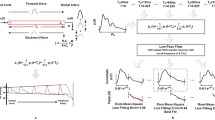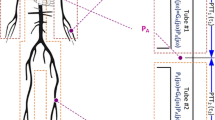Abstract
The methods for evaluating noninvasive blood pressure (NIBP) monitors using an intra-arterial reference are detailed in the ANSI/AAMI/ISO 81060-2:2009 standard. In a recent study, GE Healthcare obtained invasive radial arterial blood pressure waveforms. The work presented here describes the development of filtering strategies for obtaining high fidelity intra-arterial pressure waveforms for NIBP accuracy testing using the 81060-2 standard. The natural frequency and damping factor of each subject-catheter–transducer system was computed from fast-flush transients. These parameters were used to construct filters for removing or reducing resonance artifacts. Additionally, new optimal damping factors were evaluated for designing compensation filters. Theoretical measurement systems using actual damping factors (< 0.4) and natural frequencies were found capable of generating significant systolic resonance artifacts (≥ 8 mmHg). Typical filters that may be standardly available in monitoring equipment were observed to be potentially inadequate in removing resonance artifact. Filters with particular optimal damping factors (0.6–0.7) were effective in removing resonance artifact. Clinicians need to understand that resonance artifacts potentially exist in intra-arterial waveforms and that the adjustments of monitoring systems may not be adequate. Optimal filters for obtaining intra-arterial waveforms should take into account the damping factor and natural frequency of the measuring system. In research and device evaluation studies it is necessary that optimal filtering be done to minimize the effects of under-damping.









Similar content being viewed by others
References
ANSI/AAMI/ISO 81060-2:2009. Non-invasive sphygmomanometers—part 2: clinical validation of automated measurement type. Arlington, Virginia: Association for the Advancement of Medical Instrumentation; 2009.
Geddes LA, Bourland JD. Estimation of the damping coefficient of fluid-filled, catheter–transducer pressure-measuring systems. J Clin Eng. 1988;13(1):59–62.
Geddes LA. Handbook of blood pressure measurement. Clifton: Humana Press; 1991. p. 27–37.
Gardner RM. Direct blood pressure measurement—dynamic response requirements. Anesthesiology. 1981;54(3):227–36.
Damenstein A, Stout RL, Wessel HU, Paul MH. Electronic compensation for pressure waveform distortion by fluid-filled catheters. Med Biol Eng. 1976;14(2):186–92.
Plasman JLC, Timmers CMM. Direct measurement of blood pressure by liquid-filled catheter manometer systems. Einthoven, EUT Report 81-E-121, ISBN 90-6144-121-8, 1981.
Schwid HA. Semiautomatic algorithm to remove resonance artifact from the direct radial artery pressure. Biomed Instrum Technol. 1989;23:40–3.
Kleinman B. Understanding natural frequency and damping and how they relate to the measurement of blood pressure. J Clin Monit. 1989;5(2):137–47.
Romagnoli S, Romano SM, Bevilacqua S, Lazzeri C, Gensini GF, Pratesi C, Quattrone D, Dini D, De Gaudio AR. Dynamic response of liquid-filled catheter systems for measurement of blood pressure: precision of measurements and reliability of the pressure recording analytical method with different disposable systems. J Crit Care. 2011;26:415–22.
Hersh LT, Sesing JC, Luczyk WJ, Friedman BA, Zhou S, Batchelder P. Validation of a conical cuff on the forearm for estimating radial artery blood pressure. Blood Press Monit. 2014;19:38–45.
Dorf RC. Modern control systems. Reading: Addison-Wesley; 1980. p. 109–43.
Powell JD, Franklin GF. Digital control of dynamic systems. Reading: Addison-Wesley; 1980. p. 53–75.
Oppenheim AV, Schafer RW. Discrete-time signal processing. Englewood Cliffs: Prentice Hall; 1989. p. 403–513.
Van Valkenberg ME. Network analysis. 3rd ed. Englewood Cliffs: Prentice Hall; 1974. p. 139–324.
Wilkinson MB, Outram MD. Principles of pressure transducers, resonance, damping and frequency response. Anaesth Intensive Care Med. 2008;10(2):102–5.
Conflict of interest
GE Healthcare compensated Clinimark Physiology Labs of Louisville, Colorado for managing and executing the clinical portions of this study. GE Healthcare funded all aspects of this study.
Author information
Authors and Affiliations
Corresponding author
Additional information
The authors were employees of GE Healthcare while performing this study.
Rights and permissions
About this article
Cite this article
Hersh, L.T., Friedman, B., Luczyk, W. et al. Evaluation of filtering methods for acquiring radial intra-artery blood pressure waveforms. J Clin Monit Comput 29, 659–669 (2015). https://doi.org/10.1007/s10877-014-9649-4
Received:
Accepted:
Published:
Issue Date:
DOI: https://doi.org/10.1007/s10877-014-9649-4




